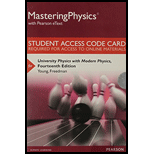
Van der Waals bonds occur in many molecules, but hydrogen bonds occur only with materials that contain hydrogen. Why is this type of bond unique to hydrogen?
Why hydrogen bonds occur only with materials that contain hydrogen.
Answer to Problem 42.1DQ
The hydrogen bonds occur only with materials that contain hydrogen because only hydrogen has a singly ionized state with no remaining electron cloud.
Explanation of Solution
Explanation:
Hydrogen bond is an attraction between hydrogen bound to a more electronegative atom and another adjacent atom having a lone pair of electrons. It is stronger than van der Waals bond while weaker than ionic and covalent bonds.
In hydrogen bond, a proton gets between two atoms, polarizing them and attracting them by means of the induced dipoles. Hydrogen bond is unique to hydrogen containing compounds because only hydrogen has a singly ionized state with no remaining electron cloud. The hydrogen ion is a bare proton, much smaller than any other singly ionized atom.
Conclusion:
Thus the hydrogen bonds occur only with materials that contain hydrogen because only hydrogen has a singly ionized state with no remaining electron cloud.
Want to see more full solutions like this?
Chapter 42 Solutions
Mastering Physics with Pearson eText -- Standalone Access Card -- for University Physics with Modern Physics (14th Edition)
Additional Science Textbook Solutions
Modern Physics
The Cosmic Perspective
Introduction to Electrodynamics
Applied Physics (11th Edition)
Conceptual Physical Science (6th Edition)
Sears And Zemansky's University Physics With Modern Physics
- The internuclear distance (bond length) of carbon monoxide molecule is 1.13 Å. Calculate the energy (in joules and eV) of this molecule in the first excited rotational level. Also calculate the angular velocity of the molecule. Given atomic masses of 12^C = 1.99x10^-26 kg; 16^O = 2.66x10^-26 kg.arrow_forwardIn this problem you will model the mixing energy of a mixture in a relatively simple way, in order to relate the existence of a solubility gap to molecular behavior. Consider a mixture of A and B molecules that is ideal in every way but one: The potential energy due to the interaction of neighboring molecules depends upon whether the molecules are like or unlike. Let n be the average number of nearest neighbors of any given molecule (perhaps 6 or 8 or 10). Let Uo be the average potential energy associated with the interaction between neighboring molecules that are the same (A-A or B-B), and let UAB be the potential energy associated with the interaction of a neighboring unlike pair (A-B). There are no interactions beyond the range of the nearest neighbors; the values of Uo and UAB are independent of the amounts of A and B; and the entropy of mixing is the same as for an ideal solution. Show that when the system is unmixed, the total potential energy due to all neighbor-neighbor…arrow_forwardIn this problem you will model the mixing energy of a mixture in a relatively simple way, in order to relate the existence of a solubility gap to molecular behavior. Consider a mixture of A and B molecules that is ideal in every way but one: The potential energy due to the interaction of neighboring molecules depends upon whether the molecules are like or unlike. Let n be the average number of nearest neighbors of any given molecule (perhaps 6 or 8 or 10). Let Uo be the average potential energy associated with the interaction between neighboring molecules that are the same (A-A or B-B), and let UAB be the potential energy associated with the interaction of a neighboring unlike pair (A-B). There are no interactions beyond the range of the nearest neighbors; the values of Uo and UAB are independent of the amounts of A and B; and the entropy of mixing is the same as for an ideal solution. Find a formula for the total potential energy when the system is mixed, in terms of x, the fraction…arrow_forward
 An Introduction to Physical SciencePhysicsISBN:9781305079137Author:James Shipman, Jerry D. Wilson, Charles A. Higgins, Omar TorresPublisher:Cengage Learning
An Introduction to Physical SciencePhysicsISBN:9781305079137Author:James Shipman, Jerry D. Wilson, Charles A. Higgins, Omar TorresPublisher:Cengage Learning Modern PhysicsPhysicsISBN:9781111794378Author:Raymond A. Serway, Clement J. Moses, Curt A. MoyerPublisher:Cengage Learning
Modern PhysicsPhysicsISBN:9781111794378Author:Raymond A. Serway, Clement J. Moses, Curt A. MoyerPublisher:Cengage Learning


